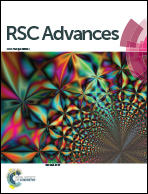Enhanced antifungal activity of Ni-doped ZnO nanostructures under dark conditions†
Abstract
In this work, we report the antifungal activity of undoped and Ni-doped ZnO nanoparticles (NPs) synthesized using a reflux method in the absence of structure-directing agents under mild reaction conditions. The Ni-doped ZnO NPs were prepared with different molar concentrations of Ni (0–6%) in the starting solution, and the effect of Ni-doping on the structural, morphological and optical properties was assessed, along with their antifungal activity and cytotoxicity. X-ray diffraction confirmed the formation of the single phase hexagonal wurtzite structure of ZnO, and the successful incorporation of Ni ions into the ZnO host matrix without the formation of secondary phases. Fourier transform infrared spectroscopy showed a frequency shift in the Zn–O vibration bands due to the incorporation of Ni ions into the ZnO lattice. Scanning electron microscopy images revealed the variation in the morphology of the ZnO NPs with Ni-doping. With an increase in Ni-doping, the absorption edge and the near band edge emissions exhibited a red-shift in the UV-vis absorption and photoluminescence (PL) spectra, respectively, while the defect related visible emission in the PL spectra was quenched. The antifungal effectiveness of the undoped and Ni-doped ZnO NPs was studied using Candida albicans fungi in vitro in the dark, while their cytotoxicity was assessed using HEK293T and HEp2 cells. The experimental results showed that the incorporation of Ni into the ZnO matrix has a beneficial influence on the bioactivity, since the ability of the ZnO NPs to kill the fungi and their cytocompatibility were significantly enhanced due to Ni-doping. By combining the experimental results with FESEM analysis, it was hypothesized that (i) the direct interaction of NPs with the cell membrane, and (ii) the generation of reactive oxygen species from the surface of ZnO are the two possible mechanisms responsible for the enhanced antifungal activity of the Ni-doped ZnO NPs.


 Please wait while we load your content...
Please wait while we load your content...